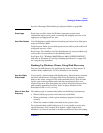
Backup
Backing Up Windows Systems
Chapter 5 181
For example, if you use Active Directory to publish Certificate
Revocation Lists (CLRs), back up the Active Directory services along
with the Certificate Services.
• Remote Storage Service
Remote Storage Service (RSS) is used to automatically move
infrequently accessed files from local to remote storage. Remote files
are recalled automatically when the file is opened. Although RSS
databases are part of System State data, you must back them up
manually. Refer to “Backing Up a Remote Storage Service Database”
on page 181.
• System File Protection Service
System File Protection (SFP) service scans and verifies the versions
of all protected system files after you restart your computer. If the
SFP service discovers that a protected file has been overwritten, it
retrieves the correct version of the file and then replaces the incorrect
file. Data Protector enables you to back up and then restore protected
files without overwriting them. The protected files can be backed up
using the Move Busy Files option in a standard filesystem backup
procedure.
• DNS, DHCP, and WINS
See “Backing Up WINS, DHCP, and DNS” on page 178.
Backing Up the DFS
Data Protector backs up the Windows 2000/XP/Server 2003 Distributed
File System (DFS) as part of one of the following:
• Windows 2000/XP/Server 2003 Registry, if the DFS is configured in a
standalone mode.
• Windows 2000/XP/Server 2003 Active Directory, if the DFS is
configured in a domain mode.
Backing Up a Remote Storage Service Database
Data Protector allows you to back up the Remote Storage Server (RSS)
database by following the standard filesystem backup procedure. The
RSS databases must be backed up offline. You can stop and restart the
Remote Storage Service using pre- and post-exec scripts, or you can
perform this manually before and after the backup. Use the following
commands:


















